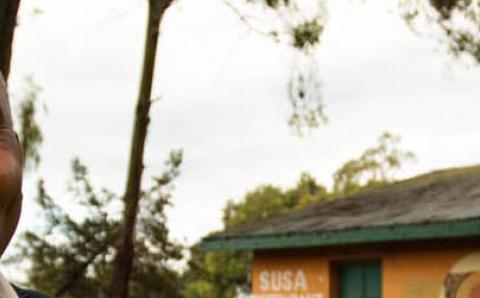I am on the upper edge of being a digital native. As defined by Wikipedia, a digital native is “a person who was born during or after the general introduction of digital technologies and through interacting with digital technology from an early age, has a greater comfort level using it. . . . In most cases, the term focuses on people who grew up with the technology that became prevalent in the latter part of the 20th century and continues to evolve today.”
Technology is essential in my life. This means that, as a digital native minister of word and sacrament, church is not just what happens on Sunday morning. Church is also what happens in the digital world. Technology is woven into my understanding of how I practice my faith. The church, the body of Christ, is vibrantly alive. And every time I’m on Twitter, I see the people of God wrestling with difficult topics in the company of fellow pilgrims.
Church leaders sometimes bemoan the ills of social media. But I want to offer another perspective. I want to encourage the church to faithfully consider ways we might integrate social media into the care and development of God’s people.
Let me share with you one very practical experience of how I used social media in the church I serve as a minister in the Upper West Side of Manhattan. The church does not have screens in its sanctuary and probably never will. We are warmly liturgical and value being together in the flesh. Earlier this summer I was preaching on Luke 24, where the resurrected Jesus appears to his disciples and tells them, in verse 48, “You are witnesses of these things.” Essentially Jesus was telling them, “Yo! You are storytellers of the faith. Each of you has a story about your encounter with the resurrection. Go and tell people your story!”
Inspired by Smith magazine’s “Six-Word Memoir,” I took a faith twist and tweeted my followers, “If you had to tell your story of faith in six words what would you say? #MySixWordStoryOfFaith.” The hashtag allowed us to curate a conversation that quickly went global. My Twitter followers tweeted their six-word story of faith, and their followers tweeted . . . and pretty soon it wasn’t just a conversation among Christians. Muslims began sharing their faith, and Jews began sharing their faith, and people of all different faiths began sharing their six-word story of faith. I used examples from Twitter during my sermon on Sunday morning, and then I invited my congregation to go on Twitter and add their six-word story of faith after worship. Social media helped facilitate this very cool experience.
Being the church in the digital world means we must be open to the many ways God’s people gather. We gather in a pew and we gather online. In each of these places we can find the living Christ present.
So here are a few ideas to consider as you and your fellow church members focus your creative processes on ways to “do church” in a digital world.
1. Meeting someone online is just as much real life as meeting someone in person is. Twitter is real life. Facebook is real life. Snapchat is real life. Instagram is real life. Sitting together in pews is real life. This is very important to understand. Real doesn’t mean just what happens in the flesh; real also means what and who I interact with on my screen. We need to develop a theology that integrates these virtual experiences.
2. You need to stop saying, “You use Twitter/SnapChat/Kik/Facebook too much." Nope, you don't get it. Being a digital native means these are our hangouts. These are the spaces we live in.
3. The front door to your church is not only the one made of wood or metal in the building. The front door to your church is also your website, your Facebook page, your Twitter. Just as you have greeters at the door on Sunday morning to welcome people, make sure you have people who are tending to your social media presence.
4. Don't just promote events. Relationally show up in your social media spaces. Theologically speaking, incarnationally inhabit your social media spaces. Get to know the people who are your online “neighbors.”
5. Ministers, remember that pastoral care doesn't only happen in your office with two wooden chairs and the coffee table. Pastoral care can happen in 140 characters, and it can also happen in a 10-second Snap. I especially think this is true for Facebook messages. I have ministered to people in my congregation who have reached out to me through Facebook messages. I have even prayed with people through the medium of Facebook messaging. I don’t want to neglect the “in the flesh” meeting, but if we are to be a people who care about others, we need to be open to caring for people in the neighborhoods where they hang out. This includes social media.
6. Watch the video “Christ Has No Online Presence but Yours” written by Meredith Gould.
7. Consider how the gathering of God’s people on Sunday can be woven into their daily digital lives. For example, create a Tumblr account for your church. Invite people to post pictures or quotes of the ways people see Jesus Christ in the world. Obviously you will need someone to curate this. Perhaps you are doing a sermon series on compassion, and you decide to invite your congregation to take pictures of places and people where they see compassion in the world. Create a hashtag related to your church to collect the pictures—i.e. #WestEndCompassion.
8. If you don't have a YouTube channel, explore the possibility. You can post video segments of worship so that people who are not able to come to worship have access to worship. Perhaps you want to invite people in your congregation to make videos to share their stories of faith and post them on your channel. Think of the possibilities for extending community!
9. Consider creating a Pinterest board for your church. Use it to post prayers, symbols, Scripture passages, and other things that can help people feel connected to the body of Christ. This would be especially meaningful to homebound members.
10. My best friend, Rev. John Russell Stanger, and I have created a new YouTube channel called The Real Reverends of NYC. We wanted to create a show that is as much silly as serious, where we can talk about our engagement with Scripture as much as our love of pop culture. It's new and we are in the process of dreaming what this could possibly be as we try out different ideas. Check it out!
What about you? What ways of “doing church” would you add to this list? Invite the digital natives in your church to help guide the conversation. What would you want the church to know about your connection to faith and technology?
About the Author
Jes Kast-Keat is associate minister at West End Collegiate Church in New York City. You can follow her @jeskastkeat where she tweets about church, New York City, and pop culture.








